 W
WThe Angels of Mons is a story of the reputed appearance of a supernatural entity which protected the British Army from defeat by the invading forces of the German Empire at the beginning of World War I during the Battle of Mons in Belgium on 23 August 1914.
 W
WArs nova refers to a musical style which flourished in France and the Burgundian Low Countries in the late Middle Ages: more particularly, in the period between the preparation of the Roman de Fauvel (1310s) and the death of composer Guillaume de Machaut in 1377. The term is sometimes used more generally to refer to all European polyphonic music of the fourteenth century. For instance, "Italian ars nova" is sometimes used to denote the music of Francesco Landini and his compatriots. The "ars" in "ars nova" can be read as "technique", or "style". The term was first used in two musical treatises, titled Ars novae musicae by Johannes de Muris, and a collection of writings attributed to Philippe de Vitry often simply called "Ars nova" today. However, the term was first used to describe an historical era only by Johannes Wolf in 1904.
 W
WFrançois Bailleux was born in Liège on 23 August 1817, and died there of heart failure on 24 January 1866. A lawyer by profession, he played a leading part in the revival of Walloon literature after Belgium gained its independence.
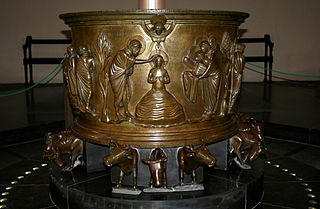 W
WThe baptismal font at St Bartholomew's Church, Liège is a Romanesque brass or bronze baptismal font made between 1107 and 1118 now in St Bartholomew's Church, Liège in Liège, Belgium. The font is a major masterpiece of Mosan art, remarkable for the classicism of its style, whose origin has been the subject of great debate among art historians. The Meuse River valley in modern Belgium and France, roughly coterminous with the Diocese of Liège, was the leading 12th-century centre of Romanesque metalwork, which was still the most prestigious medium in art.
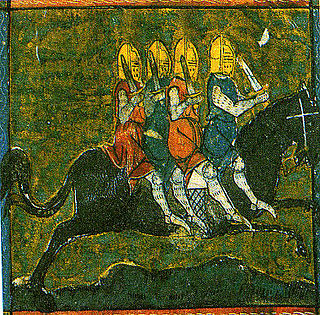 W
WBayard is a magic bay horse in the legends derived from the chansons de geste. He is renowned for his spirit, and possesses the supernatural ability to adjust his size to his riders.
 W
WThe carnival of Binche is an event that takes place each year in the Belgian town of Binche during the Sunday, Monday, and Tuesday preceding Ash Wednesday. The carnival is the best known of several that take place in Wallonia, Belgium at the same time and has been proclaimed as a Masterpiece of the Oral and Intangible Heritage of Humanity listed by UNESCO. Its history dates back to approximately the 14th century.
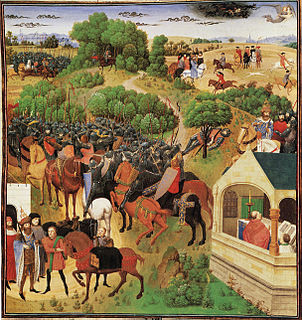 W
WThe chanson de geste is a medieval narrative, a type of epic poem that appears at the dawn of French literature. The earliest known poems of this genre date from the late eleventh and early twelfth centuries, shortly before the emergence of the lyric poetry of the troubadours and trouvères, and the earliest verse romances. They reached their highest point of acceptance in the period 1150–1250.
 W
WLe Chant des Wallons or Li tchant des Walons (The Song of the Walloons) is the anthem of Wallonia (Belgium).
 W
WLimburger is a cheese that originated in the Herve area of the historical Duchy of Limburg, which had its capital in Limbourg-sur-Vesdre, now in the French-speaking Belgian province of Liège. The cheese is especially known for its strong smell caused by the bacterium Brevibacterium linens.
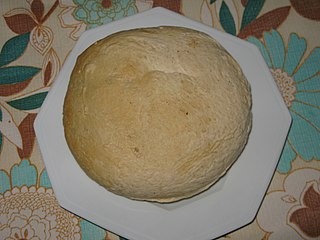 W
WFaluche is a traditional bread in the Nord-Pas-de-Calais region of northern France and the Tournai region of southern Belgium.
 W
WThe flag of Wallonia is a sub-national flag in Belgium that represents the Walloon Region and French Community. Designed in 1913, the flag depicts a red rooster, commonly known as the bold rooster or Walloon rooster, on a yellow field. The red and yellow coloring is historically associated with the city of Liège. The flag's association with Wallonia also mean that it is commonly used by the Walloon Movement.
 W
WFlamiche is a specialty of Picardy, and a puff pastry tart made with leeks and cream. The pastry is made of a brioche type dough. It resembles a quiche. It is also a speciality of Dinant and of Walloon cuisine, a tart made from a base of low-fat cheese butter and eggs, is eaten hot and traditionally accompanied by Savigny, a Burgundy wine. This is traditionally a very tasty "pie" and shares a lot of the same traits as a pizza.
 W
WThe Gilles are the oldest and principal participants in the Carnival of Binche in Belgium. They go out on Shrove Tuesday from 4 am until late hours and dance to traditional songs. Other cities, such as La Louvière, have a tradition of Gilles at carnival, but the Carnival of Binche is by far the most famous. In 2003, the Carnival of Binche was proclaimed one of the Masterpieces of the Oral and Intangible Heritage of Humanity by UNESCO.
 W
WHerve is a Belgian rind washed soft cheese made from raw cow's milk. The aging process takes place in ripening cellars of the Herve countryside, sometimes cut into its chalky rock.
 W
WThe Institut du Patrimoine wallon (IPW) was the official public Wallonian institute created by law to protect and spread awareness of Belgian cultural heritage, specifically in Wallonia.
 W
WLorrain is a dialect spoken by a minority of people in Lorraine in France, small parts of Alsace and in Gaume in Belgium. It is a langue d'oïl.
 W
WLuxembourgish is a West Germanic language that is spoken mainly in Luxembourg. About 600,000 people speak Luxembourgish worldwide.
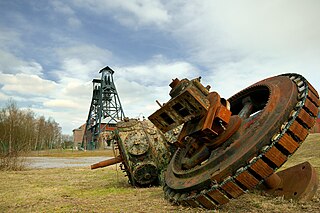 W
WThe Major Mining Sites of Wallonia is a UNESCO World Heritage Site comprising four sites in Wallonia in southern Belgium associated with the Belgian coal mining industry of the 19th and 20th centuries. The four sites of the grouping, situated in the French-speaking Hainaut Province and Liège Province, comprise Grand-Hornu, the Bois-du-Luc, the Bois du Cazier and Blegny-Mine.
 W
WThe Manifesto for Walloon Culture, was published in Liège on 15 September 1983 and signed by seventy-five "key figures in artistic, journalistic and university circles" of Wallonia.
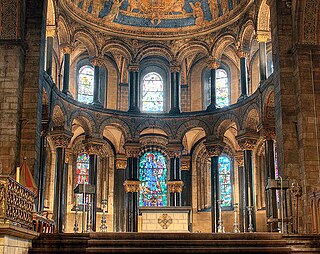 W
WMosan art is a regional style of art from the valley of the Meuse in present-day Belgium, the Netherlands, and Germany. Although in a broader sense the term applies to art from this region from all periods, it generally refers to Romanesque art, with Mosan Romanesque architecture, stone carving, metalwork, enamelling and manuscript illumination reaching a high level of development during the 11th, 12th and 13th centuries.
 W
WOrval Brewery is a Belgian trappist brewery located within the walls of the Abbaye Notre-Dame d'Orval in the Gaume region of Belgium.
 W
WRemoudou, or in wallon r'moûdou, is a Belgian cheese from the Land of Herve. It derives its name from the use of milk from a second milking performed 15 minutes after the usual milking. Hence the Wallon verb rimoûd meaning "to re-milk". This cheese weighs 200 to 500 g. When it is washed with salt it gets a strong taste, and when washed with milk it keeps a mild taste. It is often sold in pieces.
 W
WThe Sequence of Saint Eulalia, also known as the Canticle of Saint Eulalia is the earliest surviving piece of French hagiography and one of the earliest extant texts in the vernacular langues d'oïl. It dates from around 880.
 W
WSirop de Liège is a Belgian jam or jelly-like spread. Apple and pear are principally used, often with dates: other fruit such as apricot can be used as well. Sugar and other sweetners are not normally needed.
 W
WThe Son is a 2002 Belgian-French mystery film directed by Jean-Pierre and Luc Dardenne.
 W
WThe Stavelot Bible is a Romanesque illuminated manuscript Bible in two volumes datable to 1093-1097. It was produced for, but not necessarily in, the Benedictine monastery of Stavelot, in the Principality of Stavelot-Malmedy of modern Belgium, and required four years to complete. It was probably the main liturgical Bible of the monastery, kept on the altar of the abbey church or in the sacristy, rather than in the library. It is one of the most important Mosan manuscripts of the last quarter of the 11th century, and shares some of its scribes and artists with the earlier Lobbes Bible and a manuscript of Josephus, in all of which a monk called Goderannus was at least a scribe, and possibly the main artist. For many years it was in the Royal Library at Bamberg, until it was acquired by the British Library in London, where it is catalogued as Add MS 28106-28107. The pages measure 581 x 390 mm, and there are 228 and 240 leaves in the two volumes.
 W
WWallonia is one of the three Regions of Belgium—alongside Flanders and Brussels.
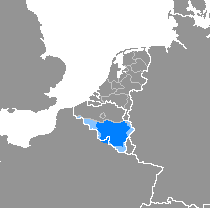 W
WWalloon is a Romance language that is spoken in much of Wallonia and in Brussels, Belgium; some villages near Givet, northern France; a clutch of communities in northeastern Wisconsin, U.S.; and in some parts of Canada. It belongs to the langue d'oïl language family, the most prominent member of which is the French language. The historical background of its formation was the territorial extension since 980 of the Principality of Liège to the south and west.